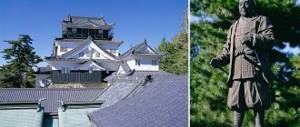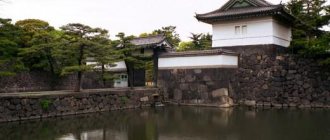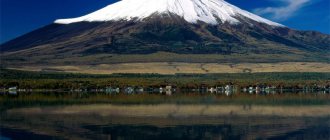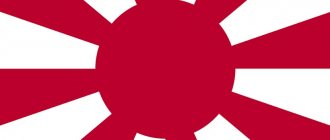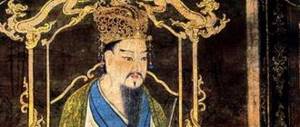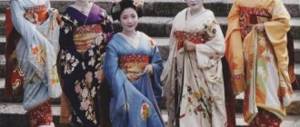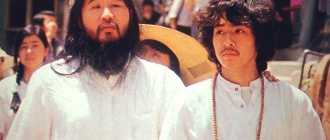The era of the warring states: everyone against everyone
In one of my previous articles dedicated to my acquaintance with the genre of “souls-like” games, I already mentioned that one of my favorite games in this genre was Nioh from the Japanese studio Team Ninja. The game hooked me not only with its gameplay and various interesting game mechanics, but also with its plot, or rather, with how skillfully it intertwined real historical events and personalities with Japanese mythology.
This year, very soon, on March 13, the long-awaited Nioh 2 will be released, which, however, will not be a continuation of the first part, but, on the contrary, a prequel. This time, players will travel to feudal Japan in 1555, a time when the country was torn apart by endless civil wars, and will play as a half-blood hero, a mercenary and a famous yokai hunter.
We will not reveal the details of the plot for now, but will dwell on another point - the historical background of the game. Let's try to figure out why this era of Japanese history, which is called the Sengoku period, is so interesting, and what historical characters we will probably meet while playing the game.
So, at the turn of the 15th and 16th centuries, Japan was in a state of deep crisis. The internecine feudal wars that began in the 60s of the 15th century, the so-called wars of the Onin years, were the beginning of the almost century-long period of “Sengoku Jidai,” when there was virtually no single government in the country.
The Sengoku period began with the loss of control over the country by the shoguns (as large military feudal lords who actually ruled the state were called in Japan) from the Ashikaga dynasty, which led to the decentralization of state power in 1467-1477, and ended with the establishment of the Tokugawa shogunate in 1603.
In 1493, a kanrei (adviser to the shogun) named Hosokawa Masamoto staged a coup, removing the shogun Ashikaga Yoshiki and installing Ashikaga Yoshizumi in his place. In 1507, Masamoto was killed by his vassals who were dissatisfied with his policies. After his death, a split occurred in the Hosokawa house; some of its members supported the new shogun, while another group supported the old one.
In 1509, a powerful daimyo (large feudal lord) from the western provinces, Outi Yoshioki, at the head of a large army, captured the capital, Kyoto, and appointed his protege as shogun.
However, the struggle between the two factions of the Hosokawa house flared up with renewed vigor. The leader of one faction was Hosokawa Takakuni, the leader of the other was Hosokawa Harumoto. When Ouchi Yoshioki returned to his possessions in 1518, Takakuni actually headed the government of the bakufu, occupying the positions of ruler of 4 provinces at once.
In 1527, Takakuni, attacked by the troops of Hosokawa Harumoto, fled from Kyoto, and four years later committed suicide. Hosokawa Harumoto became the head of the military government. But in 1543, Hosokawa Ujitsuna entered the fight against him, declaring himself Takakuni’s successor.
One of Harumoto’s most powerful vassals, Miyoshi Nagayoshi, went over to Ujitsuna’s side. In 1548, he expelled shogun Yoshihara and Hosokawa Harumoto from the capital. As a result, Miyoshi Nagayoshi became the most powerful prince of the central provinces of Japan. But the legitimacy of his power was weak and Nagayoshi was forced to constantly repel enemy attacks.
In 1564 Nagayoshi died. The then reigning shogun, Ashikaga Yoshiteru, was a strong personality and came into conflict with the actual heirs of Nagayoshi, who formed a group called the "Miyoshi Sanninshu". Initially, Matsunaga Hisahide, one of Nagayoshi’s vassals, was in close alliance with them. In 1565, the shogun was killed by Miyoshi Sanninshu warriors who attacked him.
The very next year, a conflict broke out between the former allies: Matsunaga Hisahide entered into a war with the Miyoshi sanninshu. During this time, several shoguns managed to change on the throne. And in 1568, Yoshiaki became the 15th and last shogun from the Ashikaga clan, with the support of the daimyo from Owari province Oda Nobunaga.
At a time when powerful princes succeeded shoguns at will, numerous principalities arose on the periphery of Japan, founded by the so-called sengoku daimyo. These local princelings descended from former military governors - shugo, or came from the ranks of provincial magnates. Some sengoku daimyo even had ignoble origins. These princes, who were virtually independent rulers of their lands from the shogun, waged endless wars among themselves for territory.
Despite constant civil strife, the Sengoku period, compared to previous centuries, became the time of Japan's most active relations with the outside world. If previously the Japanese knew only India, China, Korea and the countries of the South Seas, then in the middle of the 16th century they learned that the world was much more extensive. The first Europeans appeared on Japanese soil in 1543: during a typhoon, a Chinese sailing ship was forced to land on the small island of Tanegashima off the southern coast of Kyushu. Among its passengers were three Portuguese.
From that time on, the Portuguese began to regularly visit Japan, both on Chinese ships and on their own ships. Following the merchants, as was usual in those days, Catholic missionaries appeared. In 1549, Jesuits arrived on the island of Kyushu and began actively preaching Christianity. It should be noted that the activities of missionaries in Japan were very successful. Wanting to attract Portuguese ships to the ports located on their territory, many large daimyo converted to Christianity.
In the conditions of constant feudal wars, firearms aroused special interest - muskets and arquebuses, which in Japan were called tanegashima, after the name of the island where Europeans first arrived. The daimyos who fought with each other greedily bought new weapons, and soon established their own production.
Chinese-made arquebuses were first used by Murakami Yoshikiye warriors at the Battle of Uedahara in 1548. Portuguese arquebuses were tested by Shimazu Takahisa during the storming of Kajiki Castle in Osumi Province in 1549.
The Portuguese ships equipped with cannons aroused no less interest among the Japanese. Later, with the help of European specialists, the Japanese built many of their own warships. The help of Europeans was also used in the construction of castles, as well as in industry.
As for the tenno emperors, after the strengthening of the power of the Ashikaga shoguns in the 15th century, almost nothing remained of their former political power and economic power. However, they continued to retain an important symbolic and religious status.
The beginning of the unification of Japan is closely connected with the name of Oda Nobunaga, a poor feudal lord from the province of Owari in the central part of the island of Honshu. This truly legendary character has already appeared in the first part of Nioh, and it is reliably known that he will appear in the second. Therefore, it would be useful to say a few words about him.
Very little is known about the first years of Nobunaga’s life, only that he was born in 1534. His father, Nobuhide, began the fight for the unification of the Owari province. He was a capable man and managed to attract many allies to his side. But in 1551 he died suddenly, and his son, Nobunaga, became the head of the Oda house.
Owari was a large province with a complex political situation. Its convenient location attracted the attention of powerful neighbors who sought to get their hands on it. The greatest danger came from the east and north. In the east, Oda's enemy was the powerful daimyo Imagawa Yoshimoto, who belonged to the house of Ashikaga shoguns. In the north, the independence of Owari Province was threatened by Saito Dosan. nicknamed “the viper” for his treachery.
From the very beginning, the actions of the young Oda Nobunaga were distinguished by firmness and extraordinary cruelty in the implementation of plans to quickly capture the entire province, where the house of Oda initially belonged only to the western part. He had to assert his leadership both in the province and in the family with the help of force and diplomacy, concluding various kinds of alliances, which disintegrated as soon as there was no longer a need for them.
The first step towards unifying the province was a military campaign against the daimyo Saito Dosan. He was the most notorious scoundrel even among the Sengoku daimyo. Oda Nobunaga captured his heavily fortified Inabadze Castle, located in the western part of Mino Province.
The next, even more significant campaign was carried out by Oda Nobunaga against one of the largest feudal houses of Imagawa, which owned the provinces of Mikawa, Totomi and Suruga.
Having united with his relative, a major feudal lord and famous commander Takeda Shingen, Imagawa moved an army of 25 thousand to the Oda domain. In the difficult battle of Okehazama in May 1560, Oda Nobunaga, commanding much smaller forces, inflicted a crushing defeat on the army of Imagawa Yoshimoto.
The military successes of Oda Nobunaga, whose age was barely 25, made a stunning impression on the feudal families of the neighboring provinces of central Honshu. Extraordinary activity and swiftness in preparing and carrying out more and more new campaigns brought Oda and his associates to the battlefields with the largest feudal lords - Takeda, Asai, Kitabatake, Asakura and others.
Oda Nobunaga won victories over them too, and not due to any random factors. The continuous wars that he waged literally from the first days of gaining power over the family estate revealed in him the traits of an extraordinary commander. His army, created from small samurai and peasants, was distinguished by discipline, high professional training and various innovations that increased its combat power.
First of all, Oda Nobunaga's troops, unlike other feudal lords, were equipped with firearms. A definite innovation was the creation of infantry units - ashigaru. Similar units already existed in the armies of some feudal lords, but Oda Nobunaga changed the way they were used in combat. In his troops, ashigaru units, created from peasants who became professional warriors, complemented the samurai units, while in the military practice of other feudal houses, ashigaru were used only as auxiliary units.
Shortly after the Battle of Okehazama, a meeting between Oda Nobunaga and Tokugawa Ieyasu took place at Kiesu Castle, which became significant not only for them, but also for the fate of the entire country. In the spring of 1561, they entered into an alliance and, to consolidate it, agreed on the marriage of their children.
As a result, it was decided that Tokugawa Ieyasu would conduct military operations in the north - in the provinces of Totomi and Suruga, and Oda Nobunaga and Toyotomi Hideyoshi would turn their forces to expanding territorial gains in the center of the country.
Thus, a strong and effective alliance of three feudal lords arose, which made it possible to implement the idea of unifying the country and restoring a centralized state in Japan.
In 1568, Oda Nobunaga captured Kyoto, thereby seemingly completing the process of unifying the country. But in 1582, an incident occurred at Honnōji Temple, during which Akechi Mitsuhide, one of Nobunaga's vassals, betrayed his master and killed him.
After Nobunaga's death, disputes began between prominent military leaders for the post of ruler of the united country. The winner of this dispute was Toyotomi Hideyoshi, who continued the process of unification of Japan. And finally, after the death of Hideyoshi, the Tokugawa shogunate was established. These events were already shown in the original Nioh.
Thus, in Nioh 2, through the eyes of our hero, we will most likely see the process of formation of Oda Nobunaga as a great military leader and unifier of the country. Well, at the same time we’ll fight hordes of demons, where would we be without that?
Sources
- Leman, Jean-Pierre. "The Roots of Modern Japan". Basingstoke, UK: Macmillan, 1982.
- Perez, Louis G. "Japan at War: An Encyclopedia." Santa Barbara, CA: ABC-CLIO, 2013.
Views: 3,047
Share link:
- Tweet
- Share posts on Tumblr
- Telegram
- More
- by email
- Seal
End of the Tokugawa dynasty
The Tokugawa dynasty will last long enough. In fact, for more than 250 years they ruled Japan. However, over time everything disappears. And already in the 14th century, the famous Meiji Revolution took place, during which power in Japan returned to the hands of the emperors. Meiji made many important innovations. So he reopened Japan to foreign trade. Under him, foreigners began to appear on the Japanese islands again. Meiji led Japan along the path of modernization. Japan has once again entered the world stage.
Ban on foreigners entering Japan
Finally, in the second half of the 17th century, the logical result of this policy was the ban on foreigners, under pain of death, from visiting Japanese territories.
The country was completely fenced off from the possibility of contacts with the Western world. This policy has led to contradictory results. On the one hand, Japan was able to defend itself quite successfully from European influence. The dominant religious movements in the country were Buddhism and Shintoism. On the other hand, Japan could not in this way learn the scientific achievements that Europe brought to Asia. In historical scholarship, there are different assessments of the closure of Japan.
However, in any case, what is important for us is that Japan was able to emerge from the period of the 17th - 14th centuries as a country with its own tradition, with its own culture and with its own vision of foreign policy.
Particularly popular in Japan during the Tokugawa era would be those religious movements and teachings that would support the power of the shogun, respectively. This is how Zhu Xi's teachings were known. This doctrine defended the ideals of subordination of the younger to the elders, the inviolability of traditions, and so on. Such exercises contributed to the growth of a nationalist atmosphere in the country. The Japanese were proclaimed the leading nation and it was said that their path was the most correct in the whole world.
Japanese attitude towards Europeans
Like other peoples of the Pacific region in the 17th - 14th centuries, the Japanese had to deal with the increased activity of Europeans in this region. Initially, the first shogun, Ieyasu Tokugawa, was suspicious of foreigners, but still allowed trade and settlement on the territory of the Japanese islands. However, the further it went, the more relations between the Japanese and Europeans deteriorated. The reason for this is largely that the uprisings that rose against the Tokugawa shoguns were often of a Christian nature. And it doesn’t matter whether these were peasant protests or performances of feudal lords and nobility.
Over time, namely in 1612, a decree was issued that prohibited Tokugawa citizens from accepting Christianity. Moreover, the shoguns demanded that all their subjects renounce this religion. Soon repressions against Christians on the islands will begin, and trade with Western powers will begin to collapse sharply. In 1635, a decree was issued prohibiting the Japanese from leaving the territory of the state. Moreover, those Japanese who were outside the country before the decree were issued were prohibited from returning.

